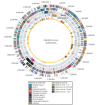Clinical characteristics of Staphylococcus epidermidis: a systematic review
- PMID: 25285267
- PMCID: PMC4184040
- DOI: 10.3205/dgkh000243
Clinical characteristics of Staphylococcus epidermidis: a systematic review
Abstract
Staphylococci are known as clustering Gram-positive cocci, nonmotile, non-spore forming facultatively anaerobic that classified in two main groups, coagulase-positive and coagulase-negative. Staphylococcus epidermidis with the highest percentage has the prominent role among coagulase-negative Staphylococci that is the most important reason of clinical infections. Due to various virulence factors and unique features, this microorganism is respected as a common cause of nosocomial infections. Because of potential ability in biofilm formation and colonization in different surfaces, also using of medical implant devices in immunocompromised and hospitalized patients the related infections have been increased. In recent decades the clinical importance and the emergence of methicillin-resistant Staphylococcus epidermidis strains have created many challenges in the treatment process.
Staphylokokken sind ein Cluster Gram-positiver unbeweglicher nicht Sporen-bildender fakultativ anaerober Kokkenbakterien, die in die zwei Hauptgruppen Coagulase-positiv and Coagulase-negativ unterteilt werden. Staphylococcus epidermidis nimmt mit dem höchsten Anteil eine prominente Stellung unter den Coagulase-negativen Staphylokokken ein und ist die wichtigste Ursache klinisch manifester Infektionen. Auf Grund der verschiedenen Virulenzfaktoren und der besonderen Eigenschaften ist diese Species häufig Ursache nosokomialer Infektionen. Auf Grund der Fähigkeit zur Biofilmbildung und der Kolonisation auf verschiedenen Oberflächen sowie auf Grund des zunehmenden Einsatzes von Implantaten bei hospitalisierten und speziell bei immunkompromittierten Patienten ist ein Anstieg derartiger Infektionen zu verzeichnen. In den letzten Jahrzehnten stellen die klinische Bedeutung und die Entstehung von Methicillin-resistenten Staphylococcus epidermidis-Stämmen neue Herausforderungen an den Behandlungsprozess.
Keywords: Staphylococcus epidermidis; coagulase-negative staphylococci; nosocomial infections; virulence factors.
Figures
References
-
- Newsom SW. Ogston's coccus. J Hosp Infect. 2008 Dec;70(4):369–372. doi: 10.1016/j.jhin.2008.10.001. Available from: http://dx.doi.org/10.1016/j.jhin.2008.10.001. - DOI - DOI - PubMed
-
- Bannerman TL. Staphylococcus, Micrococcus, and other catalase-positive cocci that grow aerobically. In: Murray PR, Baron EJ, Jorgensen JH, Pfaller MA, Yolken RH, editors. Manual of clinical microbiology. 8th ed. Washington, DC: ASM Press; 2003. p. 384–404.
-
- Komagata K, Kocur M. The nucleoside phosphotransferase test and the differentiation of staphylococci and micrococci. Spisy. 1967;40:236.
-
- Jeffries L. Menaquinones in the classification of Micrococcaceae, with observations on the application of lysozyme and novobiocin sensitivity tests. Int J Syst Bacteriol. 1966;19:183–188. doi: 10.1099/00207713-19-2-183. Available from: http://dx.doi.org/10.1099/00207713-19-2-183. - DOI - DOI
-
- Andrewes FW, Gordon MH. 35th Annual Report of the Local Government Board, Bd 1905-6. APP. B. H.M. Stationery Office; 1907. Report on the biological characters of the staphylococci pathogenic for man; pp. 543–560.
Publication types
LinkOut - more resources
Full Text Sources
Other Literature Sources



